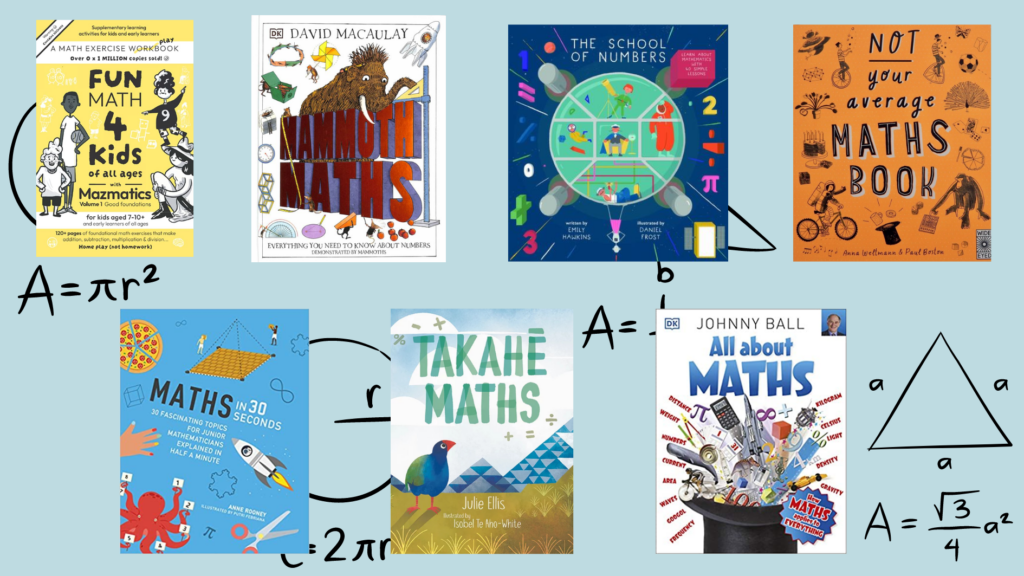A self-published maths activity book from a Wellington-based computer programmer and his family (Fun Math 4 Kids of All Ages from Mazmatics) is now available in Aotearoa, and here at The Sapling it got us thinking: what kinds of maths books are available for kids? As a self-confessed maths nerd and ex-primary school teacher, Annelies Judson took it upon herself to request a range of fun kids’ maths books from Auckland Libraries and review them together with the Mazmatics book. Full disclosure: She did not actually do any of the maths activities in the books. Fuller disclosure: She really wanted to.

Takahē Maths by Julie Ellis, illustrated by Isobel Te Aho-White
This was the only book I could find from a New Zealand publisher. As the title suggests, it’s very situated in an Aotearoa-NZ context. It’s really more story-book than maths-book, covering the fall and subsequent rebuilding of the takahē population. As the story describes the changing number of takahē at various points in history, the relevant mathematical equation is written on the opposing page. The reader is encouraged to work out how many takahē are alive at each moment.
It’s a neat little twist, and the maths isn’t too complicated so I can see it would be fun for a kid who loves maths, or a good activity for a child and adult, or class and teacher. What this book is not, is a teaching or practice book. The equations are there to support the story and encourage mathematical thinking, but the answers aren’t displayed super clearly, and the equations range from adding one (very simple) to subtracting 1,500 from 10,000 (quite a lot harder), so I think most kids wouldn’t be picking this up and doing the maths independently.

Takahē Maths
Written by Julie Ellis
Illustrated by Isobel Te Aho-White
Published by OneTree House
Maths in 30 Seconds by Anne Rooney, illustrated by Putri Febriana
This is one of those books that sets out to say, “Isn’t maths COOL?” It’s not teaching the nuts and bolts of number-and-equation maths (other than big concepts like place value), but instead looks more at the areas of geometry, measurement and statistics. Each page covers one topic (titles include Infinity, Fractals, Strange Measures and Showing Data), and many pages have a fun practical activity that illustrates what the page is talking about. It’s a great book that would appeal to the older primary school child who is already quite fascinated by mathematical ideas.

Maths in 30 Seconds
Written by Anne Rooney
Illustrated by Putri Febriana
Published by The Ivy Press
All About Maths by Johnny Ball
This is a DK book, which in my experience means a great but busy layout, lots of information, and lots of colours. This book doesn’t disappoint. Although it’s called All About Maths, it is ironically less about maths than Maths in 30 Seconds. Although there is a fair amount of maths, it actually delves into a lot of science topics (how do clocks work, nanotechnology, and gravity, among many others). It’s packed full of interesting information, and neatly includes information about influential mathematicians and scientists alongside the mathematical and scientific explanations. It’s another good one.

All About Maths
By Johnny Ball
Published by DK
Not Your Average Maths Book by Anna Waltmann and Paul Boston
This book is really a combination of the two previous books in this review, which does make the title seem a little less accurate. It covers a range of topics, similar to Maths in 30 Seconds, but with a few more nods to broader maths ideas, like playing games, superstitions about numbers, and a short history of maths. It’s well designed, includes lots of practical activities, and once again appeals to that upper-primary school age group.

Not Your Average Maths Book
By Anna Waltmann and Paul Boston
Published by Quarto Publishing Group UK
The School of Numbers by Emily Hawkins, illustrated by Daniel Frost
Look, I know this is a review about maths books, but I’m going to confess something. I love a good pun. And this book captured my attention immediately because the characters in it are all mathematical puns. A Chief of Security called “Adam Up”? Yes. “Di Ameter” the navigator? Tick. And the pièce de resistance, Flight Officer “Lois Carmen Denominator”. Whether a child will understand or appreciate the genius at work here is a moot point, but I did.
The book is written to the reader as if they are part of a crew in a spaceship, and need to learn about maths in order to be an effective astronaut
The book is written to the reader as if they are part of a crew in a spaceship, and need to learn about maths in order to be an effective astronaut. Each “lesson” starts with an intro to the “cadets,” and gives an overview of the mathematical concept being covered on those pages. It covers a lot more of the traditional maths (addition, multiplication, etc.) than the other books, but does go into other topics later on. What’s great is that it’s structured in a very logical way, and each lesson feels like it makes sense in its place. It also hits the right level of both maths AND vocabulary for an average upper-primary school child, so it seems reasonable that a child might actually be able to read and follow along with the lessons. However, I can tell you from bitter experience that a single double-page spread in a book is highly unlikely to impart mathematical skills to a child who doesn’t already have at least some basic understanding of the topic, or isn’t willing to go and practice. So as good as it is, I do think it’s still more likely to appeal to a kid who already gets it and just likes reading about maths (understandable, and may one day lead you to a job reviewing kids’ maths books).

The School of Numbers
Written by Emily Hawkins
Illustrated by Daniel Frost
Published by Frances Lincoln Publishers Ltd
Mammoth Maths by David Macaulay
I first encountered David Macaulay’s mammoths in his book The Way Things Work. In that book, mammoths are used to illustrate the workings of various machines, and the commitment to the ridiculousness of using mammoths for this task (e.g. making a mammoth catapult) lends the book a lovely dry humour. Here, it’s less ridiculous and more just a vehicle for tying the disparate mathematical concepts together by having the same characters on each page. Still, the vocabulary is well-pitched, and at a hefty 160 pages, it covers a good number of topics. And the illustrations of mammoths and shrews are pretty cute.

Mammoth Maths
By David Macaulay
Published by DK
Fun Math 4 Kids Of All Ages with Mazmatics
So, now we come to the Mazmatics book. It’s really a workbook, so in many ways, it’s unlike the other books in this review. It’s designed to be written in (including blank pages for working out equations—“or just to doodle on,” and nets for making dice that can be cut out of the book). However, what makes it a cousin of the books above, rather than a sister to the dry workbooks that pepper the maths shelves in bookstores, is the writing. It’s written like a teacher or parent talking directly to a kid and trying to make maths fun, including bad jokes, emoticons, and first-person writing (“When I look at this last one I’d actually take 1 off each side…”). There are also silly stories and narrative elements to encourage kids to use different mathematical knowledge and a range of fun/silly illustrations. It reminds me a little bit of Diary of a Wimpy Kid. All in all, it meets its aim, stated in the introduction, to make maths “fun and relatable.”
There are also silly stories and narrative elements to encourage kids to use different mathematical knowledge and a range of fun/silly illustrations
What I really like about it is that it also includes content to make kids feel good about themselves, and gives them meta-maths skills, like getting them to fill in who their “math crew” is by naming people that could help them if they get stuck. This is a really important thing to do when it comes to a subject that is so disliked by many kids (and adults). And a huge shout out to the illustrations of people throughout the book, which cover a great range of skin tones, body shapes and sizes, clothing types, and so on.
However, I will note a few critiques. First of all, it’s written with a fairly American vocabulary, including the word “math” instead of “maths,” “cookies,” and using “pounds” as a measure of weight. I suspect there’s a desire for this to be marketable internationally, but these things jar in the Aotearoa New Zealand context. Secondly, and more importantly, the structure of it isn’t great. The order of presentation of the different mathematical concepts doesn’t make sense (e.g. talking about multiplication before explaining how multiplication works). Furthermore, the explanation and the practice examples don’t always align particularly well, so if a child really was following through the book and learning from it, they would encounter questions that would not be able to be solved if they were just using what they had learnt from the text. There are also no answers, so no way for kids (or adults!) to check if what they have done is correct.
There’s a cool concept here, and it’s clear that Maz Hermon (and his kids, who co-wrote the book) are really keen on making something enjoyable and accessible
What it comes down to is that Maz Hermon, the creator of Mazmatics, is neither a teacher nor, in his own words, “particularly amazing at math.” These things are not insurmountable problems, and I’m sure that many of the authors in the books reviewed above aren’t teachers or mathematicians either. However, as a self-published book, it lacks the oversight of a professional, who could have pointed out these issues (as well as some spelling, punctuation and layout errors) and either corrected them or found an appropriate advisor from the field of mathematics education.
There’s a cool concept here, and it’s clear that Maz Hermon (and his kids, who co-wrote the book) are really keen on making something enjoyable and accessible. What is great is that there is a Mazmatics website, where they have asked for feedback about the book, and suggested that there could be more books in the future (this one is Volume 1, and they’ve “even saved room for a volume zero”). So I hope that people do try it out and send in their feedback, because it sounds like it really will be taken on board. A recent article on Stuff said that this print run was only 200 copies, which means that there is definitely the possibility of the book being refined and reprinted. I’m looking forward to reviewing Volume 1.1!

Fun Math 4 Kids Of All Ages
By Mazmatics
Self-published
Annelies Judson
Annelies Judson writes book reviews and poetry for children, among other things. Her many loves include cooking, cricket, science and the em-dash. She can be found on Twitter/X and BlueSky @babybookdel and on Instagram @annelies_judson_writer. She also has a Substack newsletter starting February 2025, @anneliesjudsonwriter.




